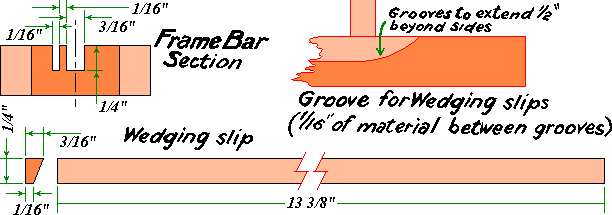Frames and Spacing
B.S. Frames
Yorkshire Spacers
|
|
|
|---|
|
Frames and Spacing B.S. Frames Yorkshire Spacers |
Abbott Style Frame used in the CDB Bee Hive |
|---|
One of the Founders of the BBKA and founder of the "British Bee Journal", Charles Nash Abbott was owner of a beekeeping equipment business, combined with a school of apiculture. He is mainly famous for the type of frame top bar that was self spacing by being broader at the end than in the central portion. This is often depicted in books as being of an 'arrowhead' shape (as the main drawing), but this style was only introduced later to save timber. The original shape had the self spacing part of the lug all on one side of the main bar with the spacer at the opposite end on the other side of the bar.

Dimensions are given in millimetres, but the design was conducted in Imperial units, The width stated for the fat portions that do the spacing was 1 1/2", which seems a little wide for the time (1 7/16" being most common in UK in those days). Top bar thickness at 1/2" is also unusual, but hives of many types were made to suit top bars of half inch thickness up until the 1940s. The sides and single bottom bar were 1/4" thick and 7/8" wide. There are no grooves in the side or bottom bars, but in order to trap foundation in the top bar a twin groove with a wedge strip was used, as the following drawing shows. The text within this drawing has been copied from the original provided by Ben Harden. The thin web of timber that occurs between the two grooves is soaked in water (by filling the grooves with warm, slightly soapy water), this wooden rib is then forced sideways to grip the inserted foundation, by hammering in the tapered wedge bar, which is shorter than the maximum length of the groove in order that the thin material does not tear at the end of the wedge bar.
It is my personal belief that the modern usage of the word 'wedge' for the strip of wood that secures the foundation in a modern frame, stems from the tapered shape of the wooden strip that is used in this type of securing method.

The original type is depicted in the next drawing, which shows three top bars as they would rest against each other. I suspect that there was a small block on the inner face of the brood box end (side) in order to take up the uneven shape and maintain the bars parallel to the face concerned.

Sometime around 1980, I made one each of the arrowhead and old type, for use as 'props' when lecturing, but I have never attempted to use such frames in bee hives.
The spacing method can be simulated by fixing 'Yorkshire' spacers on to plain top bars, and I have manipulated several hives of bees that were equipped in this fashion, but I cannot recollect if there was any benefit or detriment, although some of the metal spacers attracted large amounts of propolis, however I would suggest that any other effect was minimal, otherwise it would have been remembered.
Dave Cushman.
Page created 18/01/2005
Page updated 05/12/2022
Written... 17 & 18 January 2005, Upgraded... 18 December 2006,
|